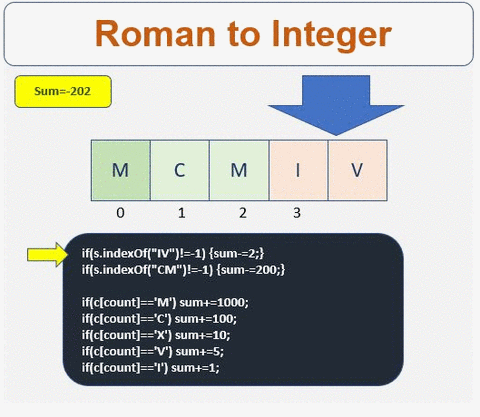| Topic | Difficulty | Companies |
|---|---|---|
| Mathematical Algorithms | Medium | Amazon|Microsoft|Facebook|Twitter |
Given a string S representing a roman numeral. Convert S into integer.
Problem Note
- S is guaranteed to be within the range from 1 to 3999.
- Roman numerals are represented by seven different symbools :
SYMBOL VALUE
I 1
V 5
X 10
L 50
C 100
D 500
M 1000 - For example, two is written as
IIin Roman numeral, just two one’s added together. Twelve is written as,XII, which is simplyX+II. The number twenty seven is written asXXVII, which isXX+V+II. - Roman numerals are usually written largest to smallest from left to right. However, the numeral for four is not
IIII. Instead, the number four is written asIV. Because the one is before the five, so we subtract one from five to make it four. The same principle applies to the number nine, which is written asIX. There are six instances where subtraction is used:
- I can be placed before V (5) and X (10) to make 4 and 9.
- X can be placed before L (50) and C (100) to make 40 and 90.
- C can be placed before D (500) and M (1000) to make 400 and 900.
Input Format
The only argument given is string A.
Output Format
Return an integer which is the integer verison of roman numeral string.Example 1
Input: "III"
Output: 3
Example 2
Input: "IV"
Output: 4
Example 3
Input: "IX"
Output: 9Example 4
Input: "LVII"
Output: 57
Explanation: L = 50, V= 5, II = 2.Hints 1
Note how the number XVI(10+5+1) and XIV(10-1+5) differs.
In one case we are adding the numeric value of a letter and in other case we are subtracting it. How can you simulate this?
Solution Approach
The key is to notice that in a valid Roman numeral representation the letter with the most value always occurs at the start of the string.
Whenever a letter with lesser value precedes a letter of higher value, it means its value has to be added as negative of that letter’s value.
In all other cases, the values get added.
Solution
class Solution {
public int romanToInt(String s) {
int nums[] = new int[s.length()];
for(int i = 0; i < s.length(); i++){
switch (s.charAt(i)) {
case 'M':
nums[i] = 1000;
break;
case 'D':
nums[i] = 500;
break;
case 'C':
nums[i] = 100;
break;
case 'L':
nums[i] = 50;
break;
case 'X' :
nums[i] = 10;
break;
case 'V':
nums[i] = 5;
break;
case 'I':
nums[i] = 1;
break;
}
}
int sum = 0;
for(int i=0; i<nums.length-1; i++){
if(nums[i] < nums[i+1])
sum -= nums[i];
else
sum += nums[i];
}
return sum + nums[nums.length-1];
}
}
